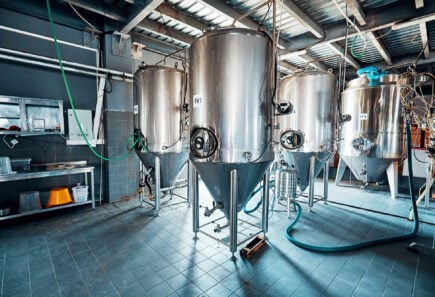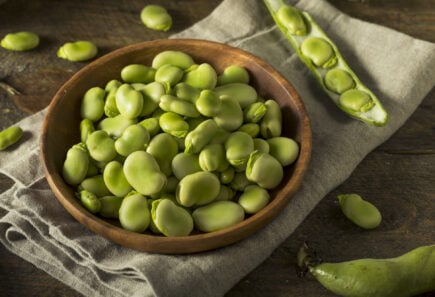
The science of plant-based meat
Learn about the science of plant-based meat. Discover resources and research projects on the latest technological developments and key scientific questions.
Introduction to plant-based meat
What is plant-based meat?
GFI uses the term “plant-based” to refer to products made from plants that are alternatives to animal-based products. This includes plant-based meat, seafood, eggs, and dairy. This overview focuses primarily on the science of plant-based meat and seafood.
The concept of plant-based meat is not a modern development. The prevalence and variety of plant-based meat has steadily increased for centuries. However, many of the early plant-based meat products were designed with vegetarian consumers in mind. Early plant-based meats did not try to exactly replicate, or biomimic, conventional meat.
Recent concerns about sustainability, food security, and the environmental and public health impacts of industrial animal agriculture have spurred a sense of urgency to develop plant-based meats that appeal to mainstream consumers rather than niche markets. This has led to an explosion of innovation during the last decade. Today’s plant-based meat options appeal to the fast-growing segment of “flexitarian” consumers.
What is the market for plant-based meat?
Flexitarian consumers are looking for plant-based meat options that create the same sensory experience as animal-based meat. These consumers deliberately reduce their meat consumption but do not completely give up animal-based products. This decision to eat more plants is often due to concerns about health, the environment, or animal protection. It may also simply be a way of obtaining novelty and variety with flavorful and affordable meals. The rise in flexitarianism is creating considerable market growth for plant-based foods.
Despite the market growth in plant-based foods, plant-based meat is currently only about 1% of the US retail meat market. For plant-based meat to become a significant part of the global meat market in the coming decades, there remains tremendous need for additional R&D. This innovation and subsequent growth of the plant-based meat industry will only be realized through a concerted and collaborative effort to direct resources (financial, human, and technological) to this area.
How is plant-based meat made?
Animal meat is primarily muscle tissue. Plants don’t have muscles. So how do the plants we see growing in a field become a piece of meat that looks, smells, tastes, and cooks like animal meat?
At its simplest level, animal meat is made up of protein, fat, vitamins, minerals, and water. Though plants don’t have muscles, they do contain protein, fat, vitamins, minerals, and water. Plant-based meat takes advantage of this biochemical similarity between plants and animals.
For every protein, lipid, or functional compound in the dozen or two animal species we typically eat, we can look for an analog or replacement in the plant kingdom. If a replacement doesn’t exist in nature, we can try to make it through mechanical, chemical, or biological treatment of a plant ingredient.
The unique spatial arrangement of proteins in muscle tissue creates the distinct texture of animal meat. Chopped or minced meat has a simpler texture and is easier to replicate than larger pieces of animal meat like chicken breasts and pork chops which are made from intact muscle tissue. The spatial arrangement of proteins in these whole-muscle types of products is integral to the texture. Thus, not surprisingly, there are more technical challenges to overcome in order to biomimic whole cuts of animal meat with plant ingredients.
The general method used to produce plant-based meat involves three primary steps. First, we grow crops as a source of raw materials. Second, we process these crops to get rid of the parts of the plants we don’t want. At this stage, we end up with the proteins, fats, and fiber ingredients that will become our plant-based meat product. Finally, we put together the desired mixture of ingredients. This ingredient mixture then goes through a manufacturing process to create the muscle-like texture needed for meat.
Whether we are making plant-based burgers, chicken kebabs, pork dumplings, or sashimi, these same general production steps apply. The rest of this page summarizes each of these three technology sectors – crop development, ingredient optimization, and end product formulation and manufacturing – in more detail. We highlight the current state, existing challenges, and forward-looking opportunities for each technology sector.
What about other plant-based alternatives?
For resources specific to plant-based dairy, please refer to GFI India’s plant-based dairy webinar and a GFI seminar on colloid approaches to plant-based milk by Dr. Julian McClements from the University of Massachusetts Amherst. For information about optimizing functional properties and applications of egg alternatives, please see GFI’s technical paper on plant-based egg alternatives.
Although fungi and algae are not biologically classified as plants, plant-based products that include fungi- and algae-based ingredients are included in our definition of plant-based foods. Products such as Meati’s steak that are made solely from fungi using fermentation processes are not classified as plant-based meat. For more information about how companies like Meati use fungal biomass fermentation to create meat analogs, please refer to the science of fermentation. For more information about microalgae and seaweed as an alternative protein source, check out GFI India’s analysis.
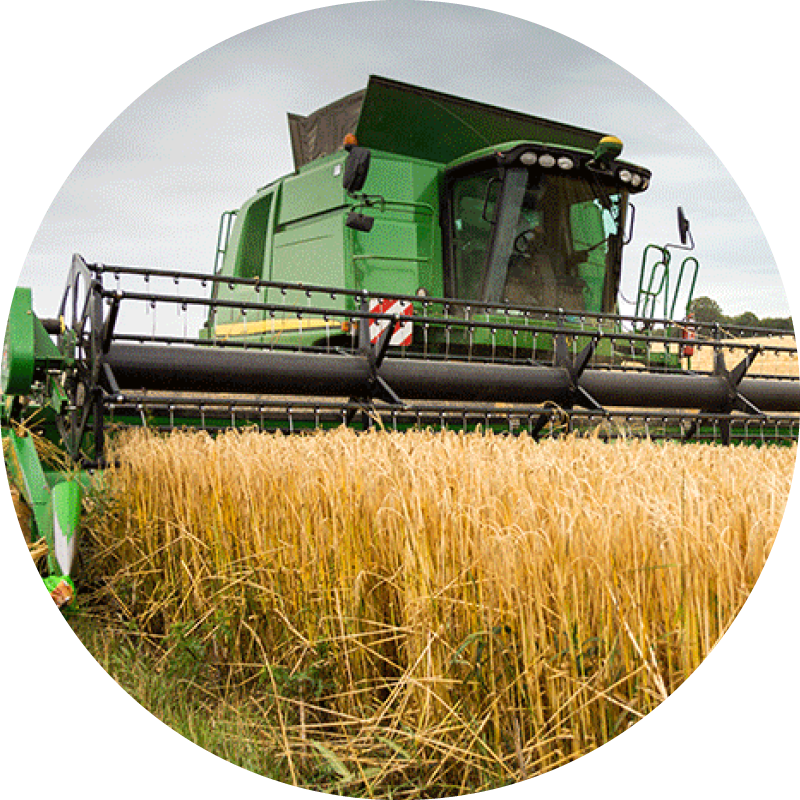
Crop development
Developing crops for plant-based meat end uses will reduce costly and time-consuming downstream processing. It can also improve the sensory and nutritional profiles of plant-based meat products.
The current state of crop development
It’s necessary to optimize crops for plant-based meat.
In addition to components like starch, fiber, and oil, plants contain proteins. Different species of plants and the different parts of plants possess different combinations of protein types and structures. The types and amounts of proteins that can be extracted from a plant create different functional properties in plant-based meat, egg, and dairy applications.
These plant-based proteins serve as the primary raw material for plant-based meat. Until recent years, soy and wheat proteins have been predominantly used in plant-based meat. But the breeding, growing, harvesting, and processing considerations for these crops have been optimized for other products rather than plant-based meat. For example, soy has been primarily optimized as an oilseed crop.
Recently, crops like pea and potato have been gaining traction for use in plant-based meat. But these crops have historically been bred and grown with an eye towards starch production. This means that the current commercial strains of soy, wheat, pea, and potato may have sacrificed protein content, composition, ease of isolation, solubility, and flavor in pursuit of maximizing desirable traits for oil or starch production.
Open-access databases linking plant protein structure-function are needed.
Some companies are building internal databases that contain data on the characteristics and function of proteins from various crops. However, these data are not publicly available.
There is some academic research underway to develop crops as a source of raw materials for plant-based meat. One line of investigation includes breeding crop varieties to possess more abundant and higher quality protein. Another avenue of research involves identifying and utilizing side streams from existing agricultural and food supply chains as a source of plant protein and ingredients.
In March 2020 Benson Hill Biosystems announced the first commercially available ultra-high protein soy varieties. Equinom is another company working to breed plants specifically as protein sources for plant-based meat, egg, and dairy.
Crop development challenges
Most crops have not been explored for use in plant-based meat.
Very little publicly-available breeding and crop development has focused on optimizing plant protein sources for plant-based meat. The vast majority of crops have not yet been explored for their suitability in plant-based meat applications. In many cases the appropriate raw materials are not available for entrepreneurs or existing plant-based meat companies to test this suitability.
The range of necessary functions for plant-based products is broad. For example, a pea protein ingredient optimized with high solubility for use in plant-based milk may be too soluble to create a fibrous texture in a plant-based meat product. Therefore, a variety of commercially-available pea protein ingredients are needed with solubility, water holding capacity, gelation, and other functional properties tuned to specific end use applications. However, plant-based meat manufacturers currently have limited choice in the sources and variety of plant ingredients that are commercially available.
The supply of novel, functional plant proteins is too limited.
When novel proteins are available, their supply is often too limited to be attractive as a primary ingredient for a new line of plant-based meat products. This limited supply can be due to low volume of production or not enough unique suppliers. In addition, the lower volume of production and the relative lack of optimization relative to commodity crops contribute to higher prices per pound for less-common plant proteins. This further disincentivizes their utilization in plant-based meat products.
Finally, growing location and conditions influence crop quality and protein characteristics. This adds variability to the starting materials in the supply chain, creating inconsistency in the midstream ingredients. This can, in turn, negatively affect the final plant-based meat products. Without in situ and high-throughput screening technologies to quickly and easily characterize the molecular components of crops, it becomes time- and resource-intensive to figure out how well a specific batch of crops will perform as a raw material for plant-based meat.
What comes next for crop development
Plant-based meat production requires optimizing crops for protein content, quality, and function.
We have an opportunity to improve the efficiency of plant-based meat production by breeding varieties of crops and other organisms that have increased protein content and quality. Strains of multiple high-protein crops should be developed such that they are optimized for plant-based meat applications. A range of breeding techniques can be used to accomplish this, from traditional breeding methods to modern genetic engineering methods.
A wide variety of high-protein beans, seeds, and grasses could serve this purpose for specific types of plant-based meat and seafood. In addition, novel protein sources that are less resource-intensive than terrestrial plants (which require arable land and significant inputs) should be cultivated and commercially grown. These may include sources like microalgae and macroalgae, fungi, and other microbes.
Simultaneously breeding for reduced off-flavors and improved sensory characteristics can increase consumer acceptance of plant-based meat. While it may take time for newly-created cultivars to enter commercial production, a quicker way to add diversity and scale to plant-based meat raw materials is to valorize existing agricultural side streams.
Future crop development may incorporate new technologies like high-throughput screening.
It is impossible to accurately predict and control severe weather events like drought or flooding that can have a range of deleterious effects on crop yield and quality. Incorporating indoor ag and vertical farming technologies to help more tightly control growing conditions may improve the consistency of raw materials used for plant-based meat. However, it is unclear whether the types and amounts of crops needed for plant-based meat can be vertically farmed economically.
Another area of opportunity is to adapt high-throughput screening methods and equipment to measure functional properties. In order to assess functional properties of hundreds or thousands of unexplored protein sources and to capture which properties are altered through variations in growing conditions and geographies, these high-throughput and systematic methods need to be readily accessible.
For assays that cannot readily be scaled down for high-throughput use, it may be possible to use computational or machine learning approaches to correlate easily-accessible parameters with performance in more complex assays.
Check out additional reading and resources
Discover seminars, GFI resources, ongoing research projects, and research opportunities related to crop development.
Featured seminars

Science of alt protein seminar: Using waste streams
Watch Dr. William Chen discuss using waste streams for microbial fermentation.

Seminar: Crop optimization
Watch GFI advisor Dr. David Welch discuss crop improvement to optimize for alternative protein to meat, eggs, and dairy.
GFI resources
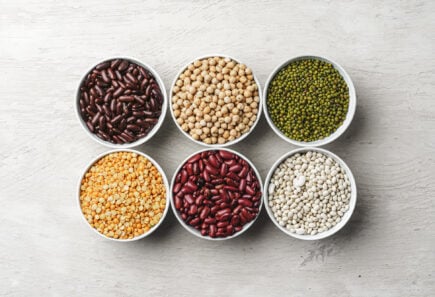
Plant Protein Primer
Find information on nutrition, functionality, price, sourcing, and consumer perceptions of plant protein sources for plant-based meat.
GFI-funded research projects
Learn about ongoing research by GFI grantees to accelerate crop optimization for plant-based meat.
Research opportunities
Explore research opportunities in crop optimization from our Advancing Solutions for Alternative Proteins database.
-
Cultivated
-
Fermentation
-
Plant-Based
Catalog of animal meat flavors
Creating a catalog of molecules responsible for the characteristic flavor of a species will enable alternative protein product manufacturers to create products that more accurately replicate the sensory experience of…
-
Cultivated
-
Plant-Based
Animal-free, non-recombinant albumin and transferrin for cultivated meat
The identification of non-animal, non-recombinant proteins with similar functionality to serum albumin and transferrin will lead to major cost reductions in cell culture media development, facilitating progress toward achieving price…
-
Plant-Based
Plant-based protein makerspaces
Plant-based protein makerspaces would be publicly available spaces where interested members of the public could learn, experiment, and work collaboratively on projects related to plant-based proteins. They could offer access…
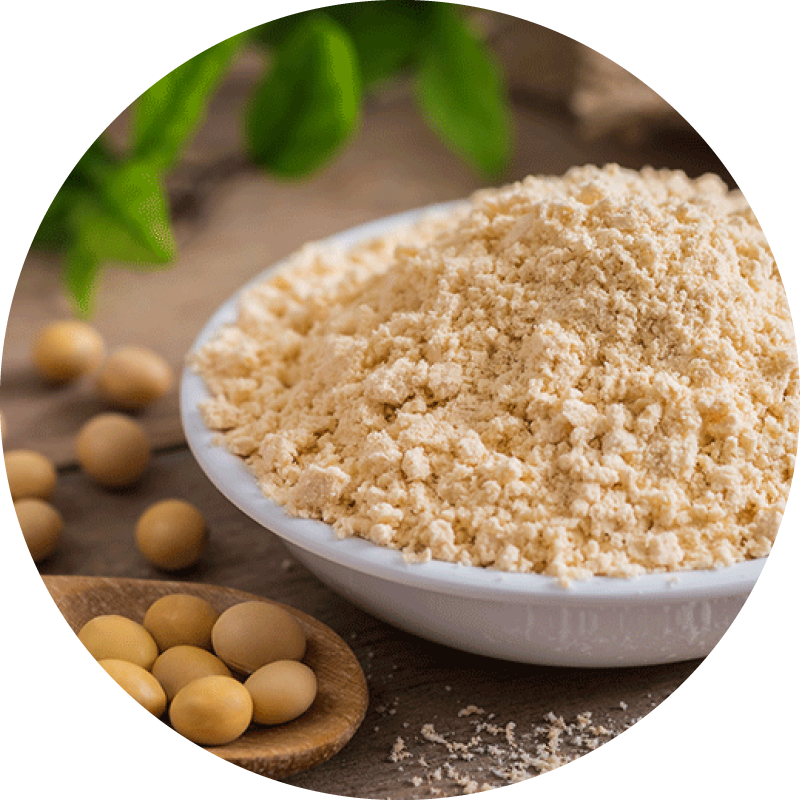
Ingredient optimization
Industry will ultimately create a use for nearly every part of the plant, sprouting more possibilities for ingredient innovation. Novel ingredient processing methodologies are needed to accommodate diverse plant sources and address the unique functional needs of ingredients for plant-based meat and seafood.
The current state of ingredient optimization
Many plant-based meats require post-harvest ingredient processing.
Some plant-based meats, such as those made from jackfruit or certain types of mushroom, require minimal post-harvest processing. However, many other plant-based meat products currently on the market rely upon plant protein concentrates or isolates as raw materials.
To obtain refined ingredients such as proteins, fats, and starches from plants, the source plant is typically milled and processed to acquire more purified and concentrated ingredient fractions. The protein fraction is typically processed into protein concentrates (around 60-70% protein content) or isolates (about 80-90% protein content).
Plant proteins can be further processed to select for specific sets of desirable functional attributes.
For example, soy protein isolates that exhibit greater solubility may be better suited for use in high-protein beverages, allowing producers to avoid a gritty or chalky taste. Plant-based meat applications may benefit from isolates that exhibit higher gelling and water holding capacity. However, this range of protein preparations with strictly defined functional parameters is not available for many crops beyond soy and wheat.
Some suppliers are beginning to branch into multiple product lines for protein concentrates and isolates from crops like pea. These newer ingredients have only recently begun to approach the diversity of options available for the traditional commodity crops.
Generally, protein concentrates and isolates serve as the base ingredient for plant-based meat. Fats and starch are also required and must be added back into recipes in smaller amounts. Even though starches, fats, and proteins may come from the same plant source, they are sold as separate fractions that are recombined during plant-based meat production.
This system of fractionation and reconstitution of the various plant components (protein and starch, most notably) helps with consistency and reproducibility of the ratios within the final formulation and allows the raw materials to be stored as shelf-stable dry fractions.
Ingredient optimization challenges
Processes like fractionation and reconstitution limit the number of cost-effective protein sources.
The process of fractionation and reconstitution is effective for creating stock ingredients for a wide variety of applications. However, this focus on purity of ingredients creates challenges because there is typically a trade-off between purity and yield. Fractionation and reconstitution also adds both time and cost to the product process, which ultimately limits the number of cost-effective protein sources available for use in plant-based meat applications.
In addition, fractionation and reconstitution use a considerable portion of the overall energy required for plant-based meat production. In the worst-case scenario, energy expenditures in this process may render plant-based meat nearly as energy-intensive as conventional animal meat. Life cycle assessment analyses point to the importance of using renewable energy to achieve sustainability goals.
Further, underutilized proteins from pulses, lentils, seaweeds, and other novel plant protein sources may require unique methods of milling and fractionation. Many of these methods have only been recently developed or have yet to be studied.
Water consumption is also a major resource concern for producing plant protein concentrates. Efforts to implement dry fractionation are being developed to support more sustainable plant-based production.
There is also the issue of co-products produced from protein extraction. For example, demand for pea protein is growing. But this creates a surplus of pea starch and fiber, the primary co-products created from pea protein extraction. If these co-products do not have a use, then the plant protein supply chain for plant-based meat will create a lot of waste. More research is needed to explore potential waste stream utilization.
The differences between animal and plant proteins create challenges.
Compared to animal proteins, plant proteins differ in size, amino acid composition, and functionality. This naturally creates challenges when trying to use plant proteins to biomimic animal proteins. Flavors are different, natural structures and textures are different, and the way the proteins behave in solution or as part of a food matrix is different.
Different plant proteins also vary.
Not even all plant proteins are similar. Among plant proteins, structures and functional properties are varied. These inherent differences influence the impacts of processing. For example, the effects of enzymatic treatment are specific to the protein sequence of each plant’s dominant storage proteins. This means hydrolysis and other forms of enzymatic functionalization can produce variable results, depending on the protein source.
Moreover, the protein extraction process itself impacts the functional and sensory characteristics of plant proteins. There is inconsistency across commercial ingredients – comparing, say, pea protein isolates from one company to another – due to variation in the treatment and extraction of the protein. Even within a single company, there may be significant batch-to-batch variability for a given ingredient.
This could be a result from when and where the crop was grown. A comprehensive data set on protein characterization and functionalization, along with an understanding of how these parameters are affected by growing conditions, extraction, and other treatments, does not currently exist publicly.
What’s next for ingredient optimization?
The quality and performance of plant-based meat would be greatly advanced by implementing environmentally friendly methods for protein conditioning. Protein conditioning, or treatment, can increase the desirable traits of the protein, such as gelation capacity, water holding capacity, and flavor.
Moreover, it may be beneficial to process crops into functional fractions instead of highly purified fractionates of single types of macromolecules. This could make the production of plant-based meat more efficient, economical, and sustainable. It can also improve the sensory profiles of the products themselves.
This is another reason why breeding high-protein crops and developing varieties with plant-based meat end uses in mind would be beneficial. Optimized crops should allow for a less intensive fractionation process, making the creation of functional fractions even easier and more efficient.
Finally, finding novel markets for fractions of the plant that are not needed for plant-based meat will be important for the sustainability of the plant-based meat supply chain. The sidestreams of starch and fiber may ultimately be utilized as feedstocks for fermentation and cultivated meat. And as the alternative protein fermentation sector and cultivated meat industry grow, the incorporation of ingredients from these processes into plant-based meat products may help to solve some of the functional, sensory, and nutritional challenges currently facing the plant-based meat industry.
Check out additional reading and resources
Discover seminars, GFI resources, ongoing research projects, and research opportunities related to ingredient optimization.
Featured seminars

Science of alt protein seminar: Optimizing oat protein
Watch GFI grantee Mari-Liis Tammik discuss optimizing oat protein using fermentation and extrusion.

Panel discussion: optimizing proteins for plant-based foods
Watch a panel discussion on optimizing proteins for plant-based foods at the Good Food Conference 2019.
GFI resources

Plant Protein Primer
Find information on nutrition, functionality, price, sourcing, and consumer perceptions of plant protein sources for plant-based meat.
GFI-funded research projects
Learn about ongoing research by GFI grantees to accelerate ingredient optimization.
Research opportunities
Explore research opportunities in ingredient optimization from our Advancing Solutions for Alternative Proteins database.
-
Cultivated
-
Fermentation
-
Plant-Based
Catalog of animal meat flavors
Creating a catalog of molecules responsible for the characteristic flavor of a species will enable alternative protein product manufacturers to create products that more accurately replicate the sensory experience of…
-
Cultivated
-
Fermentation
-
Plant-Based
Animal ingredient substitution
Enabling easy animal ingredient substitutions in a wide range of food products.
-
Plant-Based
Plant-based protein makerspaces
Plant-based protein makerspaces would be publicly available spaces where interested members of the public could learn, experiment, and work collaboratively on projects related to plant-based proteins. They could offer access…

End-product formulation and manufacturing
Art and science come together in the formulation and manufacturing of plant-based meat end products. Turning plants into meat requires understanding each ingredient, how these ingredients interact, how manufacturing conditions create meat-like texture, and a vision for how to deliver on the appearance, aroma, and taste consumers want.
The current state of end-product formulation and manufacturing
Product formulation must consider taste, texture, and nutrition.
Product formulation is a complex process that includes ingredient interactions and testing for desired texture and sensory attributes. The culinary art of flavoring is vital for creating plant-based meat that replicates the sensory palette of animal meat. Given the complexity of product formulation, this process should include both culinary experts and food scientists.
Formulation must also consider the desired nutritional qualities of the final product. In some cases, the goal is to replicate as precisely as possible the nutritional composition of animal-based meat.
In other cases, product developers may intentionally alter the nutritional profile of the plant-based meat product in beneficial ways. For example, incorporating plant fiber into plant-based meat products (which often serves a functional purpose such as binding) without sacrificing taste and texture provides a nutritive advantage to these products compared to animal-based meat (which has no fiber).
After successful formulation, the mixture of ingredients must be structured and shaped into an appropriate form.
Methods for transforming plant-based ingredient mixtures into meat products include a variety of manufacturing processes, such as stretching, kneading, shear-cell processing, press forming, folding, layering, 3D printing, and extrusion.
Each of these processes can produce unique forms and textures of plant-based meat. Processing can also impact the nutritional quality of the final product. Furthermore, different plant proteins perform differently in each of these manufacturing processes due to their unique compositions and functional properties. Therefore, it is essential to understand how particular plant proteins and combinations of plant proteins from various sources react to specific production techniques.
There are two commonly used methods of creating textured proteins: low moisture extrusion cooking (LMEC) and high moisture extrusion cooking (HMEC). More recently, researchers at Wageningen University in the Netherlands have demonstrated a pilot-scale shear cell method of fibrous plant-based meat formation. Tests indicate it uses less energy and creates gentler protein structuring than extrusion (atmospheric rather than high pressure). The shear cell technology is currently in the development stage.
End-product formulation and manufacturing challenges
Plant-based meat manufacturing by extrusion has limitations.
Currently the most popular processing method, extruders apply shear stress to proteins to align, or “structure,” them to produce a fibrous, meat-like texture. However, there are limitations to extrusion for manufacturing plant-based meat, including interference with shear force generation by the inclusion of fats in the material being extruded, and differential breakdown of amino acids due to the intense temperatures and pressures generated within the extruder. The latter results in a loss of nutritional quality of the final product.
Further, extrusion processing is subject to considerable product quality control issues as a result of variation in extruder parameter control and machine-to-machine operational variation across manufacturers. Without careful control of these parameters, product quality and characteristics can vary significantly.
Developing innovative technology for plant-based meat production will also be useful because extrusion is energy-intensive. The high capital cost of extrusion equipment (upwards of $1M for each machine) can be a barrier for new plant-based meat companies. Additionally, newer plant-based meat manufacturing methods like shear cell technology and 3D printing methods are moving the industry closer to the production of whole cuts of plant-based meat (for example, chicken breasts, steaks, and salmon filets).
So far, only ground meat products such as burgers, sausages, and nuggets have been able to truly biomimic their animal counterparts.
Creating manufacturing processes that can scale is another challenge.
Another manufacturing and formulation challenge involves identifying the optimal methods and timelines for combining proteins with other ingredients to ensure that the process is scalable while not compromising the nutritional quality or sensory aspects of the end product. For example, how and when should fats, vitamins, and carbohydrates be mixed with the protein(s) to ensure that the end product cooks properly, possesses the desired nutritional profile, taste, and texture, and does not fall apart while eating?
Critical needs exist for optimizing current technologies and developing novel manufacturing techniques for making plant-based meat. The field should place particular emphasis on technologies that optimize resource use, produce minimal waste, and could be easily adapted for use in rural areas and developing countries.
In other industries, including the conventional meat industry, the development of manufacturing processes and adaptation to changes in manufacturing systems are assisted by modeling. This enables manufacturers to understand and control parameters prior to implementation or in post-mortem analysis of failures. Unfortunately, very little modeling research has been developed for plant protein extrusion purposes.
Based on information from extrusion experts, most production processes are done by informed trial and error with new (or variable) materials, complex extruder parameters, and a trained, adaptive operator. This manufacturing system is sensitive to minor (or major) upsets and requires the presence of skilled operators. Thus, specific production processes frequently fail to translate well to other systems – either at larger scale or made by different manufacturers. This raises the cost of the product overall and limits attempts to use co-manufacturing facilities to increase production capacity.
What’s next for end-product formulation and manufacturing?
Improving texture, flavor, and color for plant-based meats is a priority.
Plant-based proteins – especially hydrolyzed proteins, which are more soluble and thus exhibit greater functionality – are often prone to bitter or “beany” off-flavors. This could be addressed by creating new bitter-blocking agents as part of a larger opportunity for developing new flavoring components, particularly those derived from natural sources and specifically designed to address the challenges of working with plant-based proteins.
Along with flavor, there is a need to develop color indicators for plant-based meat. The red-to-brown transition of animal meat during cooking is a key visual cue to consumers. Many plant-based meats do not change color in the same way or in the same cooking time as the animal meat they are attempting to replicate. Novel ingredients are being developed to improve the color indicators of plant-based meats.
Decreasing energy and capital needs is also crucial to industry growth.
New manufacturing methods – either mechanical or chemical – must be developed and scaled to produce plant-based meat at lower energy usage and with lower capital costs. Moreover, novel manufacturing techniques may be required to isolate, combine, and process the appropriate plant-based ingredients required to replicate a specific kind of meat.
Plant-based meat manufacturing systems that are amenable to installation in other countries, including developing areas of the world, are highly desired. Pre-extruded protein methods for manufacturing should be used widely for production of lower-cost foods such as plant-based chicken nuggets and fish sticks.
A specific example of research in this area is an exploration of non-extrusion methods. Chemical or biological processes – or combinations thereof – may be able to gently denature and crosslink proteins into fibrous structures without the need for high temperature, high pressure, and prohibitively expensive equipment. Exploring non-extrusion production methods will help identify whether such alternative methods may be better suited for plant-based meat manufacturing at scale.
Software development is needed to model plant-based production to allow for systems analysis and predictive capability. This will also require feedback data from existing operations to refine these models.
Ultimately, our ability to manufacture plant-based meat that biomimics animal meat may be best served through further innovation in the crops and raw materials we use. If we breed or engineer better crops for plant-based meat, we can do away with the need for additional processing steps to remove off flavors and the continuous fine-tuning of manufacturing parameters. By optimizing upstream inputs, we can improve production efficiency and consumer acceptability of the downstream end products.
Check out additional reading and resources
Discover seminars, GFI resources, ongoing research projects, and research opportunities related to end product formulation and manufacturing.
Featured seminars

Science of alt protein seminar: Using nano-emulsions to improve fat encapsulation
Watch GFI grantee Ricardo San Martin discuss adding fat to plant-based meat using nano-emulsions.

Science of alt protein seminar: Shear cell technology and plant-based protein
Watch GFI grantee Birgit Dekkers discuss shear cell technology.
GFI resources
Dig into open-access resources created by our experts.

Plant-Based Meat Manufacturing Guide
Learn about plant-based meat manufacturing by extrusion and explore directories of ingredients, facilities, and co-manufacturers.
GFI-funded research projects
Learn about ongoing research by GFI grantees to accelerate advances in end product formulation for plant-based meat.
Research opportunities
Explore research opportunities in plant-based meat end product formulation from our Advancing Solutions for Alternative Proteins database.
-
Cultivated
-
Fermentation
-
Plant-Based
Consumer and sensory research to guide alternative fish R&D
Consumer and sensory research can help companies and academic researchers better understand seafood consumers’ needs and desires. Understanding consumers’ needs will allow alternative fish researchers to ask and prioritize the…
-
Cultivated
-
Fermentation
-
Plant-Based
Catalog of animal meat flavors
Creating a catalog of molecules responsible for the characteristic flavor of a species will enable alternative protein product manufacturers to create products that more accurately replicate the sensory experience of…
-
Cultivated
-
Fermentation
-
Plant-Based
Optimizing fat profiles for nutritional and sensory properties
Because alternative meat’s fat content and fatty acid profile can be more easily controlled than conventional meat’s, there is an opportunity to alter fat content for nutritional benefits. Additional research…






